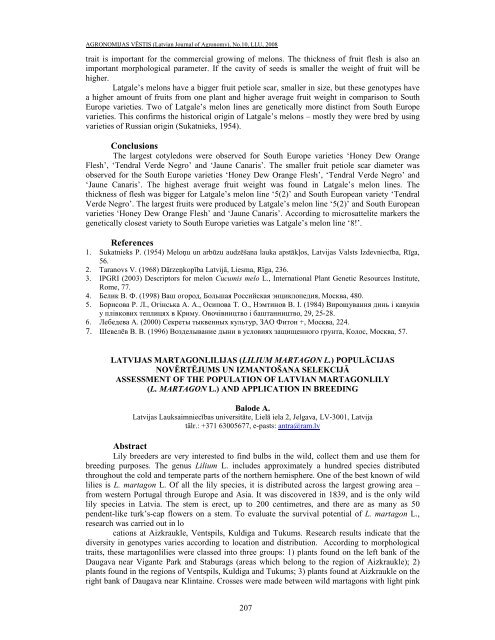AGRONOMIJAS VÄSTIS - Latvijas LauksaimniecÄ«bas universitÄte
AGRONOMIJAS VÄSTIS - Latvijas LauksaimniecÄ«bas universitÄte
AGRONOMIJAS VÄSTIS - Latvijas LauksaimniecÄ«bas universitÄte
- No tags were found...
You also want an ePaper? Increase the reach of your titles
YUMPU automatically turns print PDFs into web optimized ePapers that Google loves.
<strong>AGRONOMIJAS</strong> VĒSTIS (Latvian Journal of Agronomy), No.10, LLU, 2008trait is important for the commercial growing of melons. The thickness of fruit flesh is also animportant morphological parameter. If the cavity of seeds is smaller the weight of fruit will behigher.Latgale’s melons have a bigger fruit petiole scar, smaller in size, but these genotypes havea higher amount of fruits from one plant and higher average fruit weight in comparison to SouthEurope varieties. Two of Latgale’s melon lines are genetically more distinct from South Europevarieties. This confirms the historical origin of Latgale’s melons – mostly they were bred by usingvarieties of Russian origin (Sukatnieks, 1954).ConclusionsThe largest cotyledons were observed for South Europe varieties ‘Honey Dew OrangeFlesh’, ‘Tendral Verde Negro’ and ‘Jaune Canaris’. The smaller fruit petiole scar diameter wasobserved for the South Europe varieties ‘Honey Dew Orange Flesh’, ‘Tendral Verde Negro’ and‘Jaune Canaris’. The highest average fruit weight was found in Latgale’s melon lines. Thethickness of flesh was bigger for Latgale’s melon line ‘5(2)’ and South European variety ‘TendralVerde Negro’. The largest fruits were produced by Latgale’s melon line ‘5(2)’ and South Europeanvarieties ‘Honey Dew Orange Flesh’ and ‘Jaune Canaris’. According to microsattelite markers thegenetically closest variety to South Europe varieties was Latgale’s melon line ‘8!’.References1. Sukatnieks P. (1954) MeloĦu un arbūzu audzēšana lauka apstākĜos, <strong>Latvijas</strong> Valsts Izdevniecība, Rīga,56.2. Taranovs V. (1968) DārzeĦkopība Latvijā, Liesma, Rīga, 236.3. IPGRI (2003) Descriptors for melon Cucumis melo L., International Plant Genetic Resources Institute,Rome, 77.4. Белик В. Ф. (1998) Ваш огород, Большая Российская энциклопедия, Москва, 480.5. Борисова Р. Л., Огiнська А. А., Осипова Т. О., Нэмтинов В. I. (1984) Вирощування динь i кавунiву плiвкових теплицях в Криму. Овочiвництво i баштанництво, 29, 25-28.6. Лебедева А. (2000) Секреты тыквенных культур, ЗАО Фитон +, Москва, 224.7. Шевелёв В. В. (1996) Возделывание дыни в условиях защищенного грунта, Колос, Москва, 57.LATVIJAS MARTAGONLILIJAS (LILIUM MARTAGON L.) POPULĀCIJASNOVĒRTĒJUMS UN IZMANTOŠANA SELEKCIJĀASSESSMENT OF THE POPULATION OF LATVIAN MARTAGONLILY(L. MARTAGON L.) AND APPLICATION IN BREEDINGBalode A.<strong>Latvijas</strong> Lauksaimniecības universitāte, Lielā iela 2, Jelgava, LV-3001, Latvijatālr.: +371 63005677, e-pasts: antra@ram.lvAbstractLily breeders are very interested to find bulbs in the wild, collect them and use them forbreeding purposes. The genus Lilium L. includes approximately a hundred species distributedthroughout the cold and temperate parts of the northern hemisphere. One of the best known of wildlilies is L. martagon L. Of all the lily species, it is distributed across the largest growing area –from western Portugal through Europe and Asia. It was discovered in 1839, and is the only wildlily species in Latvia. The stem is erect, up to 200 centimetres, and there are as many as 50pendent-like turk’s-cap flowers on a stem. To evaluate the survival potential of L. martagon L.,research was carried out in locations at Aizkraukle, Ventspils, Kuldiga and Tukums. Research results indicate that thediversity in genotypes varies according to location and distribution. According to morphologicaltraits, these martagonlilies were classed into three groups: 1) plants found on the left bank of theDaugava near Vigante Park and Staburags (areas which belong to the region of Aizkraukle); 2)plants found in the regions of Ventspils, Kuldiga and Tukums; 3) plants found at Aizkraukle on theright bank of Daugava near Klintaine. Crosses were made between wild martagons with light pink207
















